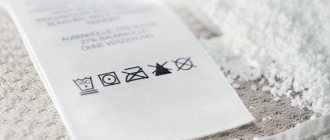Delicate translucent white fabric covering the window opening ennobles any interior, bringing a unique touch of comfort.
Windows curtained with snow-white tulle make the room cozy, elegant and a little mysterious.
Over time, under the influence of direct sunlight, dust and heating, the curtain loses its beautiful and clean original appearance.
But under the influence of ultraviolet radiation and street dust, tulle quickly loses its pristine purity. At first it “pleases” with creamy undertones, and then it can completely turn yellow. It is quite easy to avoid such an unpleasant transformation. All you need for this is knowledge of how to wash tulle until it is white.
The word “tulle” is of French origin and means transparent, mesh fabric.
Why did the tulle turn yellow or gray?
When you see that the curtains have lost their festive snow-white hue, you should not be upset. It is possible to return whiteness within 3–4 months. To decide how to bleach tulle, determine the type of material and establish the reason for the color change. Unpleasant color is caused by various factors:
- tobacco smoke;
- direct rays of the sun;
- ironing with a hot iron;
- proximity of heating devices;
- wash together with colored items;
- exhaust gases entering the apartment from the street;
- processing in hard or hot water;
- uneven rinsing, in which dust particles and grains of powder remain between the fibers.
Having established the cause of the contamination, it is easier to make the curtain white.
Kitchen curtains become dirty with soot and grease. Having determined the source of contamination, they decide how and with what to bleach the tulle from gray and yellowness.
Reference! Sometimes curtains made of organza, silk or muslin should be taken to the dry cleaner: at home it is difficult to remove dirty deposits from thin material. It is useless to try to remove old stains even with strong drugs. There is a risk of damaging textiles.
Consolidating the achieved result
The usual corn or potato starch is suitable not only for making delicious homemade jelly. He is able to restore the original whiteness of the curtain, adding a unique radiance to it.
Starch also helps to bleach white tulle, giving it dazzling purity.
The problem of how to properly starch tulle is solved quite simply:
- 250 g of the substance are dissolved in water for the penultimate rinse;
- the canvas is kept in this mixture for 3–4 minutes;
- followed by a final rinsing, shaking and hanging.
Items treated with starch are always slightly different from simply washed items.
Important! Starch not only whitens tulle and gives it shine, but also absorbs pollutants from the air. Result: after using it, it will be much easier to wash nylon or organza next time.
Starch allows you to keep curtains clean after washing.
Selecting a method
Young housewives sometimes do not know how to properly wash a tulle curtain. To wash away dirty deposits and remove stains, curtains are washed in a basin or in a machine with available products or substances for caring for fine fibers. Hand washing takes a lot of time. Automatic processing saves the housewife’s energy and time. In order not to spoil the material, return the white tint; the method, temperature and operating mode are chosen in accordance with the type of fiber.
Delicate fabrics require careful care
Machine
Despite the thinness and low strength of the material, tulle can be washed in an automatic machine, you just need to choose the right mode. Modern machines have a “Delicate Wash”, “For Synthetics”, and “Hand Wash” mode.
- You need to shake out the dust from the curtains, make sure that there are no hooks on them, carefully fold them and place them in a special bag.
- Load into drum.
- Add detergent (powder or gel).
- Set the mode, reduce the temperature to 30 degrees, turn off the automatic spin.
- After a complete cycle, let the water drain and dry the curtains.
On a note
If you don’t have a special laundry bag, you can use a thin pillowcase.
Handwash
If you know exactly how to wash a white tulle curtain by hand, even delicate organza, silk, and veil will not be damaged and will be cleaned. This is a gentle processing method in which the owner controls the process, regulates the force of influence on the canvas, preventing damage. Before washing tulle, select a washing liquid or powder and perform the following steps:
Preparing tulle
The product is removed from the cornice. Carefully shake out any dust accumulated between the threads. They try to deal with old stains before work: wash the stained area with a detergent, and wash it off after 3–40 minutes.
Additional Information! When washing by hand, avoid rough friction and the use of sponges and brushes. 10 - 15 minutes after soaking, the material is carefully squeezed and unclenched with your hands, and gently tapped.
Even dirty curtains need to be removed carefully and carefully.
Pre-soak
Pour lukewarm water into a large container and add gel or powder. Prepared items are placed in liquid. After 2–4 hours, if the textile is heavily soiled, replace the liquid with a new one. After soaking, the item is bleached. The treated curtains are rinsed twice to wash away any remaining powder and eliminate the odor. Dry flat, without squeezing: twisting causes holes and creases to appear. When the water has drained, the wet curtains are shaken and returned to the curtain rod.
Good to know, read: - The best and most effective ways to wash windows without streaks at home.
How to starch tulle in a washing machine
Silk, voile, viscose, nylon can be starched only with special means: for example, Cotico, Chirton, Frau Schmidt. But cotton and other natural fabrics can be treated with ordinary food starch: it will whiten the fabric and protect it from dust. Sequencing:
- Add 1 tsp. starch in 1 liter of water. To add shine to the tulle, add a couple of pinches of salt to the liquid.
- Stir the solution well so that there are no lumps in it.
- Pour liquid into the conditioner compartment and wash the tulle on a suitable cycle.
After washing, wipe the drum and glass of the washing machine from any remaining starch.
Automatic wash
Wet cleaning in a machine will not spoil the structure of delicate fabrics if you set the mode correctly and choose detergents. Before you decide to wash a tulle curtain so that it is snow-white and clean, you should get acquainted with the algorithm of actions.
Preparing for whitening
The curtain removed from the cornice is freed from the hooks and cleaned of dust. Before automatic processing, the product is pre-soaked. To clean and bleach a tulle curtain at home, use a substance appropriate to the type of material. Delicate fabrics tolerate non-concentrated solutions of salt and soda.
Gels are rinsed out of delicate threads without leaving any traces
Choice of product
To wash tulle curtains at home until they are white, use oxygen-containing bleaches or products for cleaning white fabrics. The volume is calculated according to the instructions. It is prohibited to use preparations containing chlorine, since the element is potent:
- destroys delicate threads;
- provokes the appearance of a yellow-gray plaque;
- causes metal corrosion and destruction of rubber outlet pipes of the machine.
It’s useful to know, read: - How and with what to remove double-sided tape in 5 minutes from different surfaces.
Before washing the tulle, it is worth softening the water, otherwise scale microparticles will get stuck between the threads and give the curtains a gray tint. To do this, powders with a softening effect (Ariel, Persil), tablets or Calgon gel are added to the detergent. Folk remedies soften liquid and whiten textiles:
- lemon acid;
- soda;
- shavings of light laundry soap.
When cleaning dense material, add soda ash.
You can soften water using folk remedies
Washing bag
The curtains are straightened, carefully folded into a rectangle and placed in a calico pillowcase or a special bag made of heat-resistant mesh. The outer shell allows water and air to pass through, retains the shape of the curtain, and protects the thin fabric from the accidental appearance of puffs and pellets. The packaged product is placed in the drum of the machine.
Reference! Even when using a bag, curtains should not be washed together with clothes and other things.
Which mode to use
Thin tulle curtains can be washed in a gentle cycle, after turning off the spin cycle. Thick linen and cotton textiles are also cleaned in a delicate mode, but spinning is allowed at low speeds. Depending on the material, it is determined at what temperature tulle curtains should be washed. Airy organza, veil or jacquard are processed by setting the low temperature mode (+30 - 35℃). When caring for flax and cotton, the temperature is increased.
Delicate mode is best for tulle.
General recommendations
It can be a simple smooth mesh tulle, airy organza or patterned lace, the main thing is that the material perfectly transmits daylight and does not weigh down the window.
- Wash your tulle curtains at least once a season without letting them get too dirty.
- Before washing, be sure to shake them out or get rid of dust using a vacuum cleaner with a special attachment for curtains. If this is not done, when wet, the dust will turn into dirt and penetrate deep into the fibers.
- Pay attention to the material from which the curtains are made. Most often, synthetic raw materials are used (polyester and nylon), so you need to observe the temperature regime and wash the curtains in water at 30 degrees. If the water is too hot, the fabric will turn gray.
- Do not forget to remove all fastenings (hooks) from the curtains, otherwise the thin material may be seriously damaged - hooks or even holes will appear.
- Such products should not be subjected to strong mechanical stress (rub and twist).
- If you are washing kitchen tulle curtains, you can soak them in a solution with a small amount of dishwashing detergent. The fat deposited on the fabric will dissolve faster, and they will immediately become lighter.
- Always wash such items separately from other items.
Features of bleaching depending on the material
To decide how to make a tulle curtain snow-white, check what material the product is made from, choose a cleaning method and bleach.
Capron
Before you start bleaching the nylon tulle, the curtain is kept in a saline solution for 45 minutes. To care for nylon, use chlorine-free preparations and home remedies:
- starch;
- brilliant green;
- blue;
- laundry soap.
Nylon is bleached in cool (+30 – 35℃) water manually or by machine, setting the delicate mode.
Additional Information! Soot and traces of grease are removed with dishwashing gel. Before wet treatment, the dirty area is lightly moistened with liquid, after 30 minutes it is washed off, and the item is washed.
Organza
Light fabric made from twisted polyester or silk fibers should not be roughly rubbed or pulled. Chemicals should not be used for whitening. Yellowness can be removed using the following means:
- light laundry soap;
- hydrogen peroxide;
- salt;
- blue;
- brilliant green.
Hand washing in cool (not higher than +35℃) water is acceptable. If you clean it in a machine, turn on the gentle program.
Special delicate approach to delicate fabrics
Batiste
Translucent fabric is woven from cotton or linen fibers. Thin textiles are resistant to high temperatures. To clean and lighten, it is permissible to boil with soap or pre-soak with starch solution or ammonia. Rinse by adding hydrogen peroxide.
Good to know, read: - 20 ways to remove traces of adhesive tape from plastic and other surfaces.
Veil
An airy veil made from cotton or silk threads must be taken care of carefully: the fibers are easily damaged. Hot water and substances containing chlorine are not used. Machine cleaning is acceptable if it is possible to set the speed to less than 400 rpm, a gentle program. Before loading into the drum, the item is carefully rolled up and placed in a mesh bag or pillowcase. You cannot wring out the veil.
With delicate products, the fabric looks like new for a long time
Kiseya
The fabric is made up of cotton, synthetic or silk threads woven together, into which beads, bugles or seed beads are woven. Needs careful but infrequent cleaning. The muslin is first soaked in starch liquid or hydrogen peroxide solution, then rinsed and washed with powder. Bleaching with ammonia after removing dirt in a powder solution.
Tulle mesh
The lightweight mesh fabric is created by weaving polyester threads and is therefore moderately durable. To keep it clean and snow-white, the curtain is dipped in a saline solution mixed with gel or washing powder. After 40 minutes, rinse.
Reference! Tulle can sometimes be treated with bleach. But if potent drugs are abused, the material will quickly lose its shine and strength.
Jacquard
The textile is woven from polyester, the weave of the fibers resembles lace. Jacquard fabrics look elegant and require careful handling. Therefore, soap, soda or mild chlorine-free products are used for bleaching. Machine wash only at low speed in cool water.
Many delicate fabrics are washed by hand
Chiffon curtains
Chiffon is a delicate material created from a mixture of cotton, synthetic and silk threads. On the surface of the canvas, puffs and pellets easily appear from a careless touch. The product is immersed in a cool soap-salt liquid until the components are completely dissolved. The washed item is not wrung out.
Tulle mesh
Dust and dirt particles accumulate in the cells. You should not pickyly choose how to bleach mesh tulle from gray: the mesh easily tolerates any bleaching compounds and processing methods. But twisting and squeezing are excluded in care: the structure of the delicate matter is quickly damaged.
It’s useful to know, read: - Simple ways to wash brilliant green in 5 minutes.
Linen tulle
Natural material is durable. Linen turns yellow in bright sun, but wears out from frequent cleaning. Before bleaching a yellowed linen tulle curtain, the item is dipped in a hot (45 - 50 ℃) washing solution. After 1.5 hours, rinse thoroughly, put in diluted ammonia or “Whiteness,” which refreshes the color of durable fiber if used rarely (once every 3 to 4 months).
Useful tips
Do not use chemicals unless absolutely necessary. And the use of chlorine is generally contraindicated. Give preference to oxygen gels. Always consider fabric composition when intending to manipulate tissue.
Rules for washing tulle made of delicate and light fabrics:
- Mechanical cleaning. There can be no question of it if the composition of the tulle is delicate: no brushes, abrasives or powders. A cleaning method that involves rubbing fabric against fabric is also discarded - it is fraught with stretching and deformation of the delicate fabric.
- Squeeze and tap. You only need to wash the tulle with light squeezes and pats of the dirty area. If the localized stain problem is not neutralized the first time, the solution used for soaking and washing is changed and the washing is repeated.
Regardless of the composition and method, before washing the tulle, it must be cleaned. It consists of getting rid of large accumulations of dust. It is convenient to carry out the procedure outdoors - just shake the curtain several times.
Under no circumstances should you use brushes or abrasives - this can lead to the formation of abrasions, permanent yellowness, pellets and even holes.
How to dry properly
To avoid fabric deformation, twisting and wringing are kept to a minimum. It is ideal to let the water drain on its own - to do this, the tulle should be hung on a rope.
Drying should be done away from heating devices. Avoid direct sunlight.
When water stops dripping from the curtains, they can be returned to their usual place - on the curtains. Thin tulle will not only dry, but also smooth out, without requiring ironing.
Ironing rules
Almost all tulle, except cotton, cannot be ironed. To avoid the need for an iron, dry properly.
If the process cannot be avoided, use low temperatures, use a cloth (for example, gauze) to iron on it, and not on the fabric of the curtain itself. Iron in “Silk” mode.
Despite the prejudice: the more you wash, the cleaner the tulle will be - frequent washing will inevitably lead to the loss of its attractive appearance. This is a sure way to damage the fabric, which is difficult or even impossible to neutralize. Therefore, wash your tulle no more than four times a year, but do it correctly.
How to make tulle white using improvised means
Ordinary substances will help restore lost whiteness. Such products are hypoallergenic, effective, and affordable.
Salt
The use of these products requires soaking.
To cleanse dirt and bleach, tulle curtains are soaked in dissolved sodium chloride (for 5 liters - ¼ cup each of washing gel and salt). After 8-10 hours, rinse and wash using the usual method.
Additional Information! If you soak very dirty curtains twice (the first time in dissolved sodium chloride, the second time you add gel), you will be able to wash off even old grease.
Aspirin
The gray coating will disappear from the fabric after soaking in dissolved aspirin (take 5 tablets for 6 liters of lukewarm water). The textiles are cleaned of dust, placed in a basin, and filled with washing liquid. After 3 hours, wash.
Soda
An alkaline solution easily removes dirt and restores the original color of even old fabric. To prepare the detergent composition, stir 30 g of sodium bicarbonate and the same amount of powder into 10 liters. An hour after soaking, the curtains are washed in a machine or by hand. Curtains made of linen or cotton are treated with soda ash, veil, organza, chiffon - only food grade.
Reference! Remove the dirty gray coating and bleach the tulle with a mixture of salt and soda: take 7 tbsp for 10 liters. spoons of alkali, 9 tbsp. spoons of rock salt. The curtains, cleaned of dust, are kept in the prepared composition for 1.5 hours, then washed thoroughly. Wash with gel or soap.
Boric acid
Folk remedies will help remove grayness and yellowness.
The drug can bleach old nylon tulle, covered with a gray coating and yellow spots. It is easy to verify the effectiveness of the method; to do this, follow these steps:
- 30 ml of boric acid is diluted in five liters of warm liquid;
- curtains are soaked for 3 hours;
- rinse.
The product, which has regained its lost snow-whiteness, is straightened. Dry in a shaded place.
Useful to know, we recommend reading: What to do if a mercury thermometer breaks at home and mercury leaks out?
Vinegar
Table vinegar removes grayness and eliminates unpleasant odors embedded in the fibers. The curtains are dipped in a lukewarm salt-vinegar solution for 3 hours (the ingredients are taken in equal parts), then washed and dried.
Ammonia
Before bleaching tulle curtains with ammonia, the item is washed and then immersed in an unsaturated ammonia solution for 1.5 hours. After bleaching, rinse.
Additional Information! If dirt has become embedded in the thin fibers, ammonia is combined with 30 ml of hydrogen peroxide. In this way, soot and grease are quickly removed, and even old tulle that hangs in the kitchen is lightened.
Lemon acid
Dry matter or juice is added during the final rinse. Before this, the curtains are cleaned with white soap and lightened with peroxide. The washed curtains are kept in dissolved citric acid. After 15 minutes, carefully squeeze out without twisting.
Citric acid whitens and removes rust marks
Hydrogen peroxide
Hydrogen peroxide is a strong bleach that helps restore the whiteness of delicate tulle items. The curtain is placed in a capacious container, filled with diluted clarifier (4 tablespoons of the drug are used for 12 liters). After 4 hours, rinse.
Potassium permangantsovka
Restore the snow-white shade, remove stains and stains with a pale pink solution of potassium permanganate. The crystals are diluted in a transparent container and combined with shavings of light laundry soap. Stir and pour into a bowl of warm water. The curtains are soaked in foamy liquid for 3 - 4 hours.
Blue
Contaminated tulle can be cleaned in a washing machine or by hand. The washed curtain is placed in diluted blue for 25 - 30 minutes to remove the gray-yellow coating. The new soft blue shade will give the item an updated look.
Reference! When using dyes - blue, brilliant green - follow the dosage recommended by the manufacturer, monitor the saturation of the liquid, otherwise the curtains will acquire an undesirable color.
Zelenka
The yellowness will disappear from nylon and tulle after soaking in a saline solution with brilliant green. A bleaching agent is prepared from the following components:
- 0.5 liters of water;
- 4 table. spoons of salt;
- 20 drops of greenery.
The ingredients are thoroughly mixed, then diluted with water. The pre-washed curtain is immersed in a liquid greenish composition. After 15 minutes, the item is hung on a rope.
Laundry soap
Light laundry soap will return the yellowed product to its purity and snow-white tone. To do this, pour 0.1 kg of washing powder and 0.15 kg of soap shavings into a basin of heated water. The components are stirred until completely dissolved. The textiles are kept in the liquid mixture for 2 hours, turning occasionally. After treatment, wash. The final stage of cleaning is a gentle machine wash.
Additional Information! Curtains made from artificial fibers should not be cleaned with soap: the fabric irrevocably loses its shine.
Wash only with white soap
Starch
Starched curtains look elegant. Starch enhances the density of natural materials and repels dust particles. To make the fabric on the window gather into elegant folds, make a weak paste:
- First, the dry substance is dissolved and put on fire.
- Stirring constantly, bring to a boil.
- The boiling paste is poured into cold water.
- Breaks up lumps.
- The canvas is immersed in the prepared paste. They wait for the material to be thoroughly saturated with starch.
- Lightly squeeze and dry.
Wet curtains are carefully ironed.
Special products for washing tulle
Curtains can be put in order not only with the help of home remedies, but also with the help of special purchased ones. The best products that return curtains to their original appearance:
FRAU SCHMIDT SUPER WHITE TULLE
"Super White Tulle" is a bleaching agent in the form of tablets that enhances the effect of the powder, designed specifically to restore the snow-whiteness of curtains. The instructions tell you how to bleach tulle with this product.
Directly into the drum of the washing machine you need to put the product at the rate of 1 tablet for the maximum drum load of three kilograms. Accordingly, if the drum load is 6 kilograms or more, then you need to put 2 tablets.
The curtains are placed in the drum and the washing powder is placed in the detergent dispenser. The amount of powder is taken in accordance with the recommendations of its manufacturer.
Curtains are washed at a temperature of 30 degrees in the “delicate”, “curtain washing” and similar modes. If necessary, you can turn on an additional rinse. Using Frau Schmidt's product is a quick way to restore them to a decent appearance and their former cleanliness.
SPLASH FOR TULLE FROM GENERAL FRESH
Another special product produced by the Polish company General Fresh, “Splash-bleach for tulle,” will help in solving the question of “how to wash tulle from grayness.” This bleach can be used both during hand washing and during machine washing. After washing the curtains by hand, you need to lower them several times into a container of water in which 30 grams of bleach have previously been dissolved.
When machine washing, the manufacturer recommends adding the product during the last rinse. Not all machine models have the option of adding the product during washing or during the last rinse, so it is more advisable to add the product after the cycle is completed and start rinsing.
Reviews for this product are positive. Everyone who used Splash noted that the desired effect was achieved without much time or physical effort.
Elixir for tulle and curtains “CASHMERE”
A bleach with similar properties and composition, including optical brightener, as the previously listed special products.
“Cashmere” is intended for bleaching specifically various tulles, curtains, curtains, especially kitchen ones. It can be used for soaking and hand washing (add 10-15 grams of product per 10 liters of water), as well as in washing machines (add 90 to 110 grams for every 2-2.5 kilograms of dry laundry).
The manufacturer not only placed recommendations on the use of this product on the packaging, he also placed some useful tips on washing rules, for example, washing temperature conditions.
Digestion
If washing the tulle did not help cope with yellowing, grandmothers and mothers boiled the curtains:
- they took a large enamel basin or bucket;
- water was poured into the container, soap shavings or powder were poured in;
- the product was placed into the liquid foam mixture;
- the container was placed on fire;
- after boiling, heated for an hour over medium heat, turning occasionally (the material was grabbed with metal tongs).
Curtains made from cotton fibers will become snow-white again after boiling.
Modern types of textiles add artificial fibers that require careful care. With prolonged boiling, delicate threads quickly melt and the fibers become deformed. Curtains made of organza, chiffon or nylon cannot be boiled. Curtains made from thick natural fabrics are sometimes boiled down, although the housewife has to control the process and should not leave the stove often.
Reference! If cotton textiles have turned yellow and dirty, the item is first boiled and then soaked in peroxide. If the dirty color remains, the fabric is kept in salted liquid, then rinsed and starched. Often this method should not be used: after 2–3 treatments, the fabric will become thinner and irrevocably lose its snow-white color.
How to make fabric turn white using household chemicals
Most older generation bleaches contain chlorine. This element disinfects and brightens quickly, but aggressively - along with the yellowness, the structure of the fibers is destroyed. Such products should be used rarely, only for dense natural materials. To care for a veil, cambric, jacquard, choose chlorine-free compounds that act gently:
- Oxygen preparations containing sodium bicarbonate, hydrogen peroxide. When interacting with water, they release oxygen. Eliminate dirt, foreign odors and quickly exhibit whitening properties without disturbing the structure of the threads. The grayish-yellow coating returns after 2 - 3 weeks, but such compositions can be used regularly for washing curtains.
- Synthetic and natural materials are treated with optical brighteners. Powders remove dirt and lighten dark stains. Reflective microparticles do not eliminate, but hide the gray-yellow coating, so the curtains appear snow-white for 3-4 weeks.
Before washing the tulle, dissolve the detergent according to the instructions. Chemical mixtures act intensively even in cool water. Textiles are placed in the prepared bleaching medium. If using a machine, the clarifier and powder are poured into a special compartment. The washed item is rinsed and hung out to dry.
White
The clarifier is 95% chlorine. Causes allergic reactions. When working, wear gloves and open windows. The active ingredient removes yellowish circles, destroys dirty gray tint, and disinfects at +30℃. It is used for the care of linen and cotton curtains, for cleaning organza; muslin is not used, because the aggressive element thins the threads. Leave the curtains in the diluted mixture for 30 minutes before final cleaning.
Whiteness destroys delicate fabrics
Additional Information! After 1 – 2 soakings in “Whiteness”, the matter gets used to the active component and stops reacting to oxygen bleaches.
Wellery delicate white washing gel
Gently lightens cotton and synthetic fabrics. Contains optical brightening microparticles and enzymes. The hypoallergenic gel returns the snow-white appearance of curtains using any cleaning method, although it cannot cope with old dark stains, stubborn dirt and grayness. Dissolves in hot and cold water. Smells nice. Easily washed out.
Chirton oxygen bleach stain remover
Fragrant particles cleanse dirt and remove even old stains from berries, soot, and grease on curtains made of cotton and synthetic fabric. Chirton oxygen is considered one of the best effective drugs that restore the lost snow-whiteness of canvases. Enhances the effectiveness of gels. Intensively whitens at any temperature.
Other means
Similar preparations are used to bleach tulle curtains.
Bleaching preparations are selected for delicate threads
Frau Schmidt
Whitening tablets are designed for the care of delicate textiles. The packaging is designed for 5 wet treatments. Optical and oxygen-containing elements, enzymes destroy stubborn dirty stains even in hard and cool (+30℃) water. Does not cause allergies.
Cashmere
Small granules with optical brightening microparticles for the care of delicate natural and artificial fabrics. The yellowed fabric is soaked and cleaned in a warm solution. Removes nicotine film and yellowed greasy stains. Removes gray plaque from kitchen curtains.
Dr. Beckmann
Oxygen-containing sachets for machine cleaning of cotton and artificial fibers. The concentrated substance whitens, eliminates foreign odors, removes dust, soot and greasy stains at +20℃. Effectiveness increases when heated. Portion bags (0.08 g) are placed together with the item in the machine drum.
Optical brighteners are used for silk
Freshbubble
Oxygen stain remover with brightening properties. Without boiling, it removes contaminants of natural and inorganic origin. The granules do not contain chlorine. Effectiveness increases at temperatures from +50℃.
Splash
An oxygen-containing brightener with optical elements designed for wet processing of delicate curtains made of nylon, cotton and linen. Splash is conveniently packaged in 30 gram bags. The packaging is designed for one use. Pre-washed curtains are immersed in dissolved powder for 0.5 hours, then rinsed thoroughly.
Clean home
Oxygen microgranules with an optical brightening component are used for soaking and washing. One spoon of small granules eliminates fresh streaks and bright stains. To wash away old circles, double the dose.
Reference! Silk curtains are treated with special powders: Laska 3D wool and silk, Unipuls, Organic People.
Basic Rules
Despite promising commercials and labels, industrial bleaching agents cope with their task only during the first wash of synthetic tulle. And if you don’t want to say goodbye to a beautiful curtain made of nylon and organza after the second use, it is better to always use time-tested folk recipes.
The curtain can have different colors and textures.
After all, since they successfully “brought to life” even easily soiled cotton fabrics, they will be able to cope with the yellowness of more resistant synthetic materials.
White tulle is mainly used for interior decoration.
The second rule is a complete rejection of high-temperature conditions. This applies to both boiling, which is considered effective, and washing at temperatures above 30–40 degrees. When treated this way, delicate organza and capricious nylon become covered with folds that require ironing. And this is an additional risk of damaging them. Therefore, it is better to prefer soaking to boiling.
White tulle makes the room more spacious, bright and does not distract attention from the interior decoration and furnishings of the room.
And thirdly, you should not deviate from the instructions below. When it comes to how to wash tulle so that it is white, exceeding the dosage of effective folk remedies or attempts to bypass some points in the manual can lead to the opposite result - the transparent curtain will become covered with stains that are difficult to remove.
A new white curtain looks elegant, beautiful, airy, but over time, collecting dust, it becomes gray.
How to remove stains
Thin transparent fabrics quickly turn yellow and gather dust. It is difficult to maintain freshness in the kitchen and keep the linens clean, even if a powerful hood is installed. Therefore, housewives are interested in how to wash tulle and remove the difficult-to-remove yellowish tint.
Rust
To remove rust stains from cambric, muslin or chiffon, the products must be dry-cleaned. At home, red spots are removed from thick cotton curtains using organic acids:
- vinegar;
- oxaline;
- lemon;
- wine
Warm water and 0.02 g of acid are mixed in a glass container. The dirty fragment is immersed in an acidic environment. After 15 minutes, the area is washed in a liquid mixture of ammonia and soda. This is repeated until the circles disappear.
Fat
Fresh splashes are removed using the following methods:
- The curtain is soaked in a soda solution. After 2.5 hours, wash with soap suds.
- The spot is sprinkled with crushed chalk. When the white particles absorb the fat, the chalk is cleaned off and a new layer is added (this is repeated until the dirt disappears).
- The fatty fragment is carefully washed with dishwashing liquid.
Old grease stains are washed off with a combination of vinegar, salt and ammonia. The components, taken in a ratio of 4:1:4, are applied to the damaged surface. After 20 minutes, the fabric is washed with liquid soap.
Additional Information! Stains are removed by moving from the contaminated periphery to the center.
Mold
A fungus that has grown on the curtains disrupts the structure of the threads and smells unpleasant. It is difficult to fight mold at home, but it is worth trying to remove a stain on dense material. The fungus is destroyed with citric acid or vinegar. First, the curtains are washed with soap or powder. Remains of detergents are washed off. The damaged area is watered with vinegar (lemon juice), and after 1.5 hours, sprinkled with salt. After the layer has dried, the material is rinsed.
Home remedies remove traces of dirt and whiten
Thin fabrics with decor require careful cleaning. It is difficult to remove grayness using improvised means: dirty stains often remain and textiles are damaged. Therefore, to clean a veil, chiffon or jacquard, you should contact a dry cleaner.
Reference! It is easier to remove stains if the product is soaked in an alkaline solution for 2 hours. The liquid will soften the dirt, wash away yellow circles and a grayish tint. Washing after pre-soaking will seal the effect of the soda.
How to carefully bleach old tulle from gray plaque and yellowness
The fibers of old curtains are thin and saturated with dust. Due to friction and exposure to bleaches, textiles can tear before they have time to turn white. Therefore, old yellow stains are removed carefully:
- before washing old tulle curtains from gray, carefully clean the item by hand or using a machine (set to delicate mode, turn off spin);
- washed curtains are soaked in a mixture of peroxide and ammonia;
- rinse and dry.
Linen or cotton fabric that can withstand high temperatures is boiled with powder or soap.
Additional Information! Synthetics are returned to white with vinegar. Add 2 tablespoons to 5 liters of cool water. l. acids. The curtain is carefully placed in an acidic medium and stirred periodically. After 3 hours, rinse.
Rules for drying and ironing
Wide canvases are difficult to care for. It is inconvenient to wash by hand in a standard container. When cleaning by machine, you have to check what speed and how many degrees are indicated on the panel. Be careful when drying and ironing, otherwise the textile will deform or melt.
Delicate material is ironed with a low-heat iron
Advice from experienced housewives will make your work easier and help you understand how to wash a tulle curtain without ironing:
- in the washing machine set the program without spin;
- When washing by hand, do not twist or wring out the fabric;
- the curtain is transferred to a dry basin and waited for it to dry slightly;
- The straightened product is dried on a ledge.
After 40 minutes, the curtain will finally dry out and, under the influence of its own gravity, straighten out. Small folds and creases that remain on a damp surface are steamed by weight or ironed through a double layer of gauze.
Tulle needs to be washed every 3 months, otherwise transparent curtains will become covered with yellowness or a layer of gray dust. Aggressive lighteners destroy delicate threads. If you regularly use delicate oxygen-containing preparations and use home recipes, the curtains will not be damaged, and the whiteness will remain for a long time.











